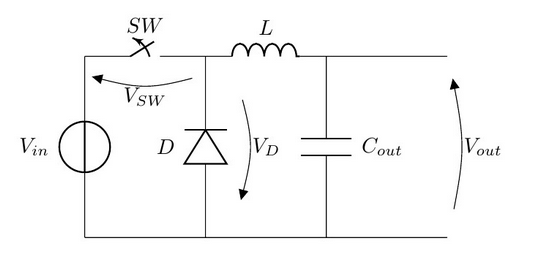| Input Voltage | | | The voltage provided to the input of the buck converter. Usually this is from a DC power supply or battery. |
| Output Voltage | | | The output voltage of a buck converter must be equal to or lower than the input voltage. |
| Diode Voltage Drop | | | The forward voltage drop across the diode when the diode is fully conducting. The diode may be replaced with an active switching element (such as a MOSFET), to reduce power losses. A MOSFET will have a much lower voltage drop than a diode. This is sometimes called the free-wheeling diode. |
| Switching Element Voltage Drop | | | The voltage drop across the switching element when the switch is fully ON. The switching element is typically a MOSFET. |
| Duty Cycle | | | The on/off duty cycle. It is given by the equation $$D = �rac{V_{out} - V_{D}}{V_{in} - V_{SW} - V_{D}} $$ It is typically expressed as a percentage. |
| Switching Frequency | | | The switching frequency of the transistor (or other switching element). |
| Average Output Current | | | The average (DC) output current of the buck converter. Note that this is usually higher than the input current! |
| Output Current Ripple | | | The is the percentage ripple of the output current. Strictly speaking, it is the ratio between the amplitude of the output current's AC component (i.e. the ripple), and the output current's DC component (the average output current). It is recommended that this is no more than 10-20%. |
| Inductance | | | The inductance of the inductor (L) in the buck converter. It is given by the equation: $$ L = �rac{ (V_{in} - V{SW} - V_{out}) cdot D }{ f_{SW} cdot Delta I_{out} } $$ |
